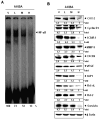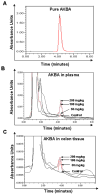Boswellic acid inhibits growth and metastasis of human colorectal cancer in orthotopic mouse model by downregulating inflammatory, proliferative, invasive and angiogenic biomarkers
- PMID: 21702037
- PMCID: PMC3246525
- DOI: 10.1002/ijc.26251
Boswellic acid inhibits growth and metastasis of human colorectal cancer in orthotopic mouse model by downregulating inflammatory, proliferative, invasive and angiogenic biomarkers
Abstract
Numerous cancer therapeutics were originally identified from natural products used in traditional medicine. One such agent is acetyl-11-keto-beta-boswellic acid (AKBA), derived from the gum resin of the Boswellia serrata known as Salai guggal or Indian frankincense. Traditionally, it has been used in Ayurvedic medicine to treat proinflammatory conditions. In this report, we hypothesized that AKBA can affect the growth and metastasis of colorectal cancer (CRC) in orthotopically implanted tumors in nude mice. We found that the oral administration of AKBA (50-200 mg/kg) dose-dependently inhibited the growth of CRC tumors in mice, resulting in decrease in tumor volumes than those seen in vehicle-treated mice without significant decreases in body weight. In addition, we observed that AKBA was highly effective in suppressing ascites and distant metastasis to the liver, lungs and spleen in orthotopically implanted tumors in nude mice. When examined for the mechanism, we found that markers of tumor proliferation index Ki-67 and the microvessel density cluster of differentiation (CD31) were significantly downregulated by AKBA treatment. We also found that AKBA significantly suppressed nuclear factor-κB (NF-κB) activation in the tumor tissue and expression of proinflammatory (cyclooxygenase-2), tumor survival (bcl-2, bcl-xL, inhibitor of apoptosis (IAP-1) and survivin), proliferative (cyclin D1), invasive (intercellular adhesion molecule 1 and matrix metalloproteinase-9) and angiogenic C-X-C (CXC) receptor 4 and vascular endothelial growth factor) biomarkers. When examined for serum and tissue levels of AKBA, a dose-dependent increase in the levels of the drug was detected, indicating its bioavailability. Thus, our findings suggest that this boswellic acid analog can inhibit the growth and metastasis of human CRC in vivo through downregulation of cancer-associated biomarkers.
Copyright © 2011 UICC.
Conflict of interest statement
Figures






Similar articles
-
Boswellic acid suppresses growth and metastasis of human pancreatic tumors in an orthotopic nude mouse model through modulation of multiple targets.PLoS One. 2011;6(10):e26943. doi: 10.1371/journal.pone.0026943. Epub 2011 Oct 31. PLoS One. 2011. Retraction in: PLoS One. 2022 Sep 28;17(9):e0275582. doi: 10.1371/journal.pone.0275582. PMID: 22066019 Free PMC article. Retracted.
-
Combined acetyl-11-keto-β-boswellic acid and radiation treatment inhibited glioblastoma tumor cells.PLoS One. 2018 Jul 3;13(7):e0198627. doi: 10.1371/journal.pone.0198627. eCollection 2018. PLoS One. 2018. PMID: 29969452 Free PMC article.
-
Ursolic acid inhibits growth and metastasis of human colorectal cancer in an orthotopic nude mouse model by targeting multiple cell signaling pathways: chemosensitization with capecitabine.Clin Cancer Res. 2012 Sep 15;18(18):4942-53. doi: 10.1158/1078-0432.CCR-11-2805. Epub 2012 Jul 25. Clin Cancer Res. 2012. PMID: 22832932 Free PMC article.
-
Boswellia serrata: an overall assessment of in vitro, preclinical, pharmacokinetic and clinical data.Clin Pharmacokinet. 2011 Jun;50(6):349-69. doi: 10.2165/11586800-000000000-00000. Clin Pharmacokinet. 2011. PMID: 21553931 Review.
-
Boswellic extracts and 11-keto-ß-boswellic acids prevent type 1 and type 2 diabetes mellitus by suppressing the expression of proinflammatory cytokines.Phytomedicine. 2019 Oct;63:153002. doi: 10.1016/j.phymed.2019.153002. Epub 2019 Jun 28. Phytomedicine. 2019. PMID: 31301539 Review.
Cited by
-
CXC chemokine ligand 12/stromal cell-derived factor-1 regulates cell adhesion in human colon cancer cells by induction of intercellular adhesion molecule-1.J Biomed Sci. 2012 Oct 25;19(1):91. doi: 10.1186/1423-0127-19-91. J Biomed Sci. 2012. PMID: 23098564 Free PMC article.
-
Frankincense myrrh attenuates hepatocellular carcinoma by regulating tumor blood vessel development through multiple epidermal growth factor receptor-mediated signaling pathways.World J Gastrointest Oncol. 2022 Feb 15;14(2):450-477. doi: 10.4251/wjgo.v14.i2.450. World J Gastrointest Oncol. 2022. PMID: 35317323 Free PMC article.
-
Cytotoxic Evaluation and Anti-Angiogenic Effects of Two Furano-Sesquiterpenoids from Commiphora myrrh Resin.Molecules. 2020 Mar 13;25(6):1318. doi: 10.3390/molecules25061318. Molecules. 2020. PMID: 32183153 Free PMC article.
-
Preclinical evaluation of 4-[3,5-bis(2-chlorobenzylidene)-4-oxo-piperidine-1-yl]-4-oxo-2-butenoic acid, in a mouse model of lung cancer xenograft.Br J Pharmacol. 2013 Dec;170(7):1436-48. doi: 10.1111/bph.12406. Br J Pharmacol. 2013. PMID: 24102070 Free PMC article.
-
Therapeutic potential of natural products in inflammation: underlying molecular mechanisms, clinical outcomes, technological advances, and future perspectives.Inflammopharmacology. 2023 Dec;31(6):2857-2883. doi: 10.1007/s10787-023-01366-y. Epub 2023 Nov 11. Inflammopharmacology. 2023. PMID: 37950803 Review.
References
-
- Pearson JR, Gill CI, Rowland IR. Diet, fecal water, and colon cancer--development of a biomarker. Nutrition reviews. 2009;67:509–26. - PubMed
-
- Ammon HP. Salai Guggal - Boswellia serrata: from a herbal medicine to a non-redox inhibitor of leukotriene biosynthesis. European journal of medical research. 1996;1:369–70. - PubMed
-
- Anthoni C, Laukoetter MG, Rijcken E, Vowinkel T, Mennigen R, Muller S, Senninger N, Russell J, Jauch J, Bergmann J, Granger DN, Krieglstein CF. Mechanisms underlying the anti-inflammatory actions of boswellic acid derivatives in experimental colitis. American journal of physiology. 2006;290:G1131–7. - PubMed
-
- Latella G, Sferra R, Vetuschi A, Zanninelli G, D’Angelo A, Catitti V, Caprilli R, Gaudio E. Prevention of colonic fibrosis by Boswellia and Scutellaria extracts in rats with colitis induced by 2,4,5-trinitrobenzene sulphonic acid. European journal of clinical investigation. 2008;38:410–20. - PubMed
Publication types
MeSH terms
Substances
Grants and funding
LinkOut - more resources
Full Text Sources
Medical
Research Materials

